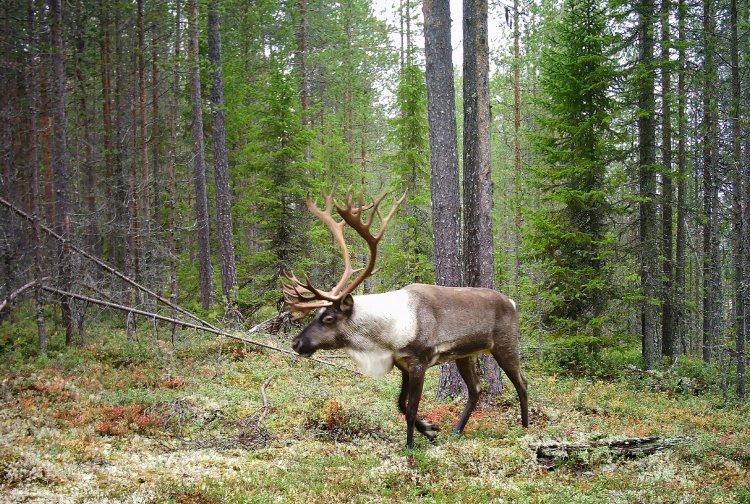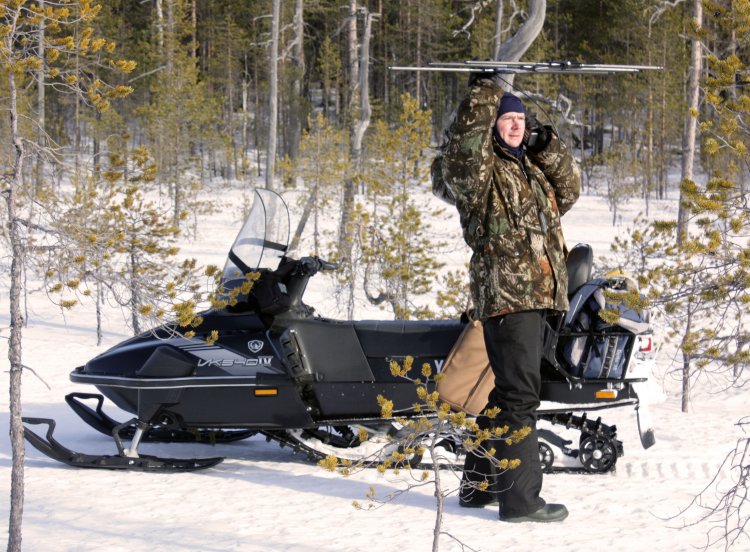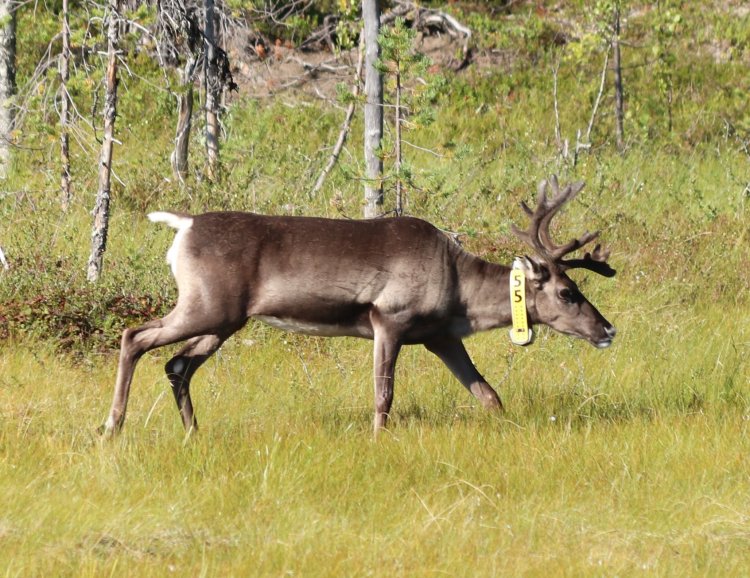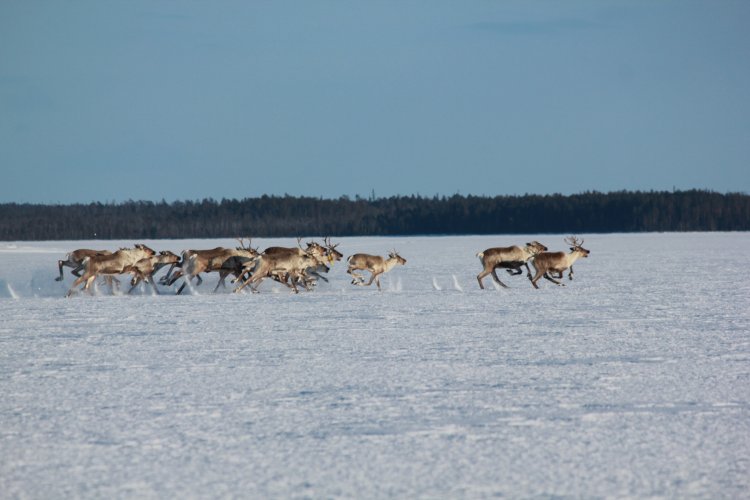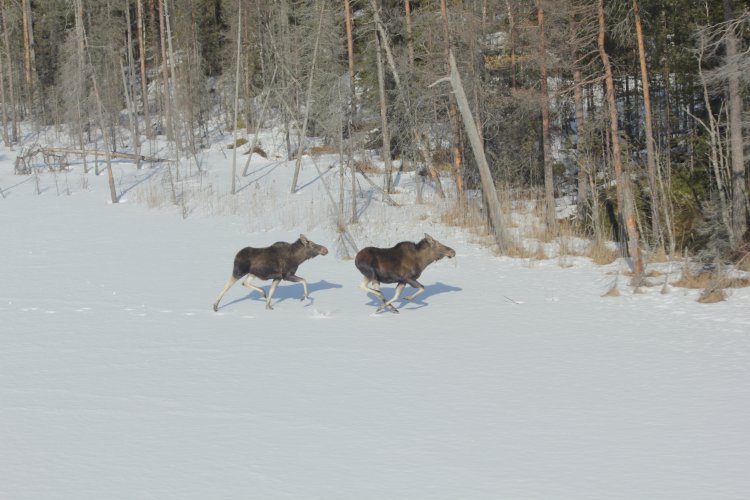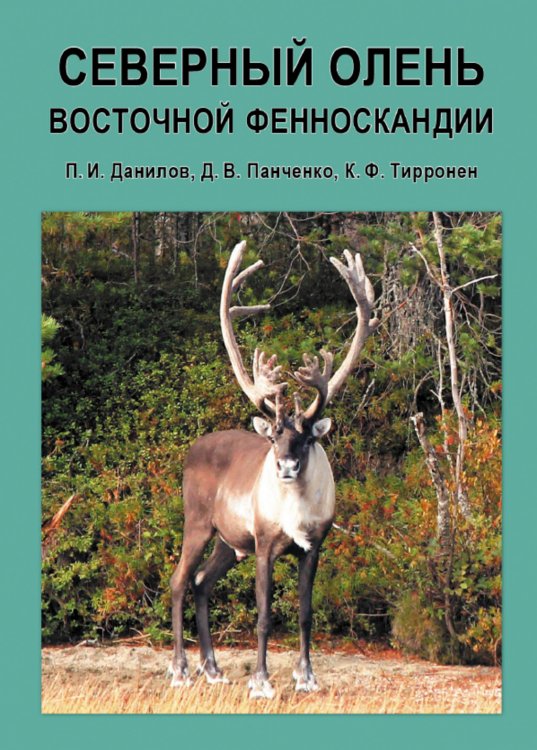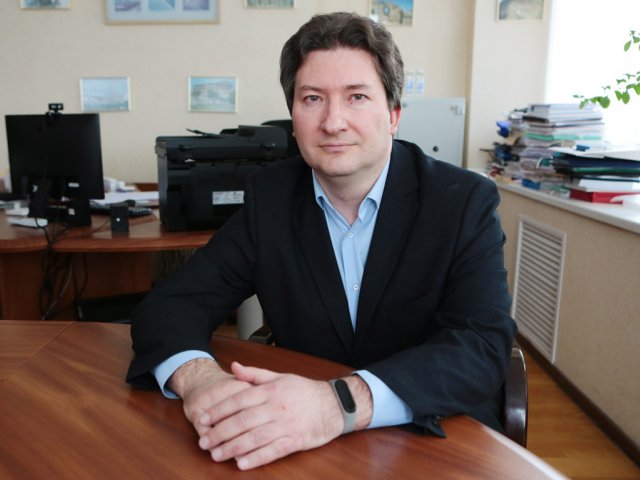Karelian scientists study the current situation of the Cervidae family populations, among them is the endangered Finnish forest reindeer
A few centuries ago, the Finnish forest reindeer was a widespread animal in the European North and therefore was a common prey of hunters. At the beginning of the twentieth century, the historical and political situation and economic conditions led to a decrease in the population of this wild animal, resulting in the presence of few groups of the species in Eastern Fennoscandia. The Finnish forest reindeer became extinct in Finland early last century as a result of unregulated hunting. Subsequently, animal dispersal from the territory of Russia, conservation measures, and reintroduction efforts have ensured that the population of this animal has recovered.
In the Republic of Karelia, the Cervidae family is represented by three species of indigenous fauna – moose, Finnish forest reindeer, and European roe deer, emerging from adjacent territories. Today the Finnish forest reindeer is facing a critical situation and requires increased attention to its conservation.
A team of scientists from the Karelian Research Center of the Russian Academy of Sciences studies the population dynamics and distribution areas of the Cervidae populations in Northwest Russia. The specialists focus their attention on the ways of seasonal migrations and peculiarities of area development by these species of the northern fauna, as well as their genetic features. But most importantly, scientists are developing measures to protect and restore populations of rare species, including ungulates, they are searching for effective monitoring methods, which will eventually help stop the decline of endangered species mainly threatened by humans.
Danila Vladimirovich Panchenko – Candidate of Biological Sciences, Senior Researcher at the Zoology Laboratory of the Institute of Biology of the KarRC RAS (Petrozavodsk) – speaks on the study of the populations of the Cervidae family, which live in the Republic of Karelia, about the conservation and monitoring activities developed and conducted by scientists, as well as about the contribution they can make in peoples’ education and popularization of the Cervidae of the Russian North.
What is the status of the Cervidae family populations in northern ecosystems today?
“The Cervidae populations have been present in the European North of Russia for quite a long time. Thus, the dispersal of ungulates across the territory of the Kola-Karelian region took place again after the last glaciation, both from the west and from the east. For example, the penetration of the wild reindeer to the Kola Peninsula probably came from Norway, while in Karelia this species made its way from Siberia. Previously, there were unsuitable living conditions during the glacier, but once it melted, the animals began to actively disperse throughout the territory of Fennoscandia becoming an integral part of the ecological communities,” Danila Panchenko informed.
A male forest reindeer (Hirvas). Republic of Karelia. Kalevala district
What are the regional characteristics of reindeer living in Karelia?
"There are several subspecies of the reindeer in Russia, but it is the Finnish forest reindeer that inhabits Karelia. This subspecies is also found in Finland and the Arkhangelsk region. In general, subspecies identification is a complex issue that requires additional research, including the use of modern genetic methods. Long migrations are not typical of the Finnish forest reindeer – during the seasonal change of habitats it migrates relatively short distances, 70-150 km, unlike, for example, the Siberian tundra reindeer, whose winter and summer pastures can be more than 1000 km away. This difference can be explained by various reasons, one of which is different landscape and climatic conditions. Taiga habitat conditions are relatively more balanced and animals do not need to travel so far in search of suitable habitats," the scientist explained.
The Finnish forest reindeer of Karelia has a different appearance compared to the tundra reindeer. "It is larger, more proportionate (its legs are longer compared to the tundra's) and has a more dignified appearance. The muzzle is narrower and longer. The crown of the antlers of the Finnish forest reindeer is narrower, V-shaped. The coloration is light brown on the sides. It has a thick dark stripe that runs horizontally on the sides along the lower edge and is clearly visible against the overall light background of the body. Dark tones in males are more prominent than in females. The coloration is lighter in winter. The tail ‘mirror’ of pure white is clearly visible. Wild forest reindeer usually form small groups, now usually of 10-20 individuals; however, there are also large herds of more than a hundred individuals. During the year they use different habitats, including high-growth pine forests, which cutting has an extremely negative effect on the condition of the groups of this species," Danila Panchenko pointed out characteristic differences of the Finnish forest reindeer.
At all times, ungulates have played an important role in human life, in ancient times they were one of the main sources of human existence. Numerous finds of reindeer and moose bones and artifacts at the sites of ancient man prove it. Well known are the rock paintings – petroglyphs of animals and hunting scenes. However, recently the representatives of the fauna of the North, in particular, the wild reindeer, are facing an enormous anthropogenic pressure, which has an extremely negative impact on the state of its populations.
Most negative factors provoking the decrease in numbers and habitat are logging, tourism and, of course, poaching, which is particularly destructive. Despite the ban, reindeer are hunted for their meat, which later gets sold.
"Hunting for wild reindeer is now banned throughout the European part of Russia, but poaching remains one of the main reasons for the decline in the species' groupings throughout its habitat area. The lack of proper land control allows illegal hunting to flourish. The situation is somewhat better in federal specially protected areas with their own staff of inspectors, as well as in border areas controlled by the border service. Private hunting farms also organize proper monitoring, which affects the preservation of deer, but some of them are destructive and have registered cases of illegal hunting in the north of Karelia," the Karelian researcher emphasized.
The situation has worsened recently, and while previously wild reindeer were only included in some regional Red Books, now the continuing decline in numbers and range has led to the inclusion of all populations of wild reindeer of the European part of Russia in the Red Data Book of the Russian Federation in 2020.
According to Danila Panchenko, "the population of the Finnish forest reindeer in Karelia has been at a low level for quite a long time and now amounts to about 2,300 individuals. Back in the late 1980s it was 6,500, but in the 1990s the situation changed due to an upsurge in poaching and the number decreased dramatically. Today, against the background of low numbers, additional factors, such as habitat destruction due to deforestation, large predators have only increased their influence and represent the main causes of the groups' distress."
In addition to native species, roe deer is also found in Karelia. As the scientist noted, "this species is not typical for the region and the border of the distribution area in Russia passes to the south (Leningrad and Vologda regions). At the same time, cases of penetration outside the range occur annually in different parts of the republic. However, it does not mean that they will inhabit this area permanently – the local conditions are not suitable for them. Even the case of roe deer grouping in the south of Karelia, the place of their regular wintering, only proves it. After severe winters they became much rarer. The influence of predators and dogs also affects them. Roe deer often come to farmlands next to settlements, including abandoned ones. There they can find more food, but they are also more likely to encounter dogs."
Scientists from the Karelian Research Center of the Russian Academy of Sciences are collecting new data on the genetic structure and genetic diversity of the Finnish forest reindeer and moose populations in Murmansk Oblast, Karelia, and Finland.
"We have evaluated the level of genetic diversity and it turned out to be high. This is largely explained by the geographical location. Karelia occupies an intermediate position between the west and the east, and its territory is crossed by the so-called taiga corridors where animals have been and are being dispersed. As a result, there is a high genetic diversity and our Finnish colleagues in this respect even called the republic a curious ‘hotspot’ for moose," the researcher gave his comments.
Moose. Republic of Karelia. Territory of the nature reserve "Kostomukshsky."
Danila Panchenko is tracking a radio signal from a collar of a wild forest reindeer. Telemetry is one of the ways to gain important information about deer movements.
Photo by K. Tirronen
A female Finnish forest reindeer with a GPS collar in the territory of Kalevala National Park. The collar was mounted by Finnish researchers. There is a common grouping of animals on the border of Karelia and Finland and their seasonal movements across the border of the countries are observed.
What methods of animal monitoring do you practice?
"As for moose, the Winter Route Census is usually used. However, reindeer are herd animals, so this method is not quite suitable here, and the best method is aerial census (using airplanes and helicopters). It helps to get accurate and reliable data, but this method is very expensive," the Karelian researcher noted.
What is the current strategy of the Cervidae family conservation in Karelia? What restoration measures are proposed at the KarRC RAS regarding the plight of the Finnish forest reindeer?
"We are combining scientific and applied approaches in our work on the conservation and restoration of the Finnish forest reindeer populations. It requires comprehensive population monitoring and a number of conservation measures, including the creation of specially protected natural areas (SPNAs), moratoria on logging in key habitats, as well as increased control of lands and the popularization of knowledge about this rare animal," Danila Panchenko replied.
A group of the Finnish forest reindeer at Topozero Lake. A female reindeer with a yellow GPS collar is visible among the animals (Republic of Karelia, Louhsky District).
Moose. Aerial Survey 2014. Republic of Karelia. Muezersky district.
As for creation of new protected areas in the Republic of Karelia, this kind of work is very active. For example, the employees of the Karelian Research Center of the Russian Academy of Sciences with the support of the World Wide Fund for Nature (WWF) have prepared materials for the creation of three protected areas in the north of the region: Starye Ozera, Kumozersky, and Kalevalsky.
The World-Wide Fund for Nature shows increased attention to the preservation of wild reindeer and regularly brings together specialists from different regions of the country to hold meetings devoted to wild reindeer. This year such an event took place in Arkhangelsk in October and was attended by scientists and staff from specially protected natural areas in the European part of Russia. During the meeting they discussed the results of their work, as well as the creation of a common program for the conservation of this unique animal.
It should be noted that scientists of the Karelian Research Center of the Russian Academy of Sciences, being engaged in research activities, place high value on educational activities. For example, last year Petr Ivanovich Danilov and his co-authors published a monograph "The reindeer of Eastern Fennoscandia," a book that systematized the results of many years of research on the reindeer in this area. The book includes a detailed description of the unique animal and peculiarities of its behavior; it is of interest not only for experts, but also for nature lovers, and helps to understand the necessity of its protection and conservation.
Danilov P. I., Panchenko D. V., Tirronen K. F. The reindeer of Eastern Fennoscandia: [monograph] / P.I. Danilov, D.V. Panchenko, K.F. Tirronen. - Petrozavodsk: KarRC RAS, 2020.
Source https://www.researchgate.net/publication/354311784_Severnyj_olen_Vostocnoj_Fennoskandii_The_reindeer_of_Eastern_Fennoscandia
Another important step in popularizing awareness about this rare representative of northern fauna and attracting attention to the problem of its conservation in the Republic of Karelia and Finland was the creation of the Finnish forest reindeer website (https://www.suomenpeura.fi/ru/lesnoj-severnyj-olenj.html). The platform of this website also suggests organizing a network of cooperation between specialists of different levels to monitor the situation and control the number of these mammal species in the territories of Fennoscandia. Information is available in three languages: Finnish, English, and Russian. The site has been prepared within the framework of the Finnish-Russian joint project on the study and conservation of wild forest reindeer (Karelia ENPI CBC), developed in cooperation with the Finnish Forestry Directorate "Metsähallitus", the Finnish Game and Fisheries Research Institute (Riista- ja kalatalouden tutkimuslaitos), and the Institute of Biology of Karelian Research Center of RAS.
It has thematic sections, which will familiarize the reader with the history of relationships between man and the wild forest reindeer, the consequences of uncontrolled hunting and the threat of extinction of this North fauna representative. There are recommendations for nature lovers on visiting parks and nature reserves in the North of Karelia, for example, how not to disturb animals in their habitats when meeting a wild forest reindeer, how to follow the accepted rules of conduct in specially protected natural territories.
We should not forget that long ago the wild reindeer helped people to conquer the harsh North: it became a means of transport, a source of food and clothing. Now this unique and beautiful animal has become an endangered species and may soon be preserved only as an exhibit in local history museums. In order to avoid this, we need to be aware of this distressing situation and take conservation measures at different levels, from the governmental officials to local residents and tourists. This is the only way to preserve this unique symbol of the North for future generations.
*All images are provided by D. Panchenko
